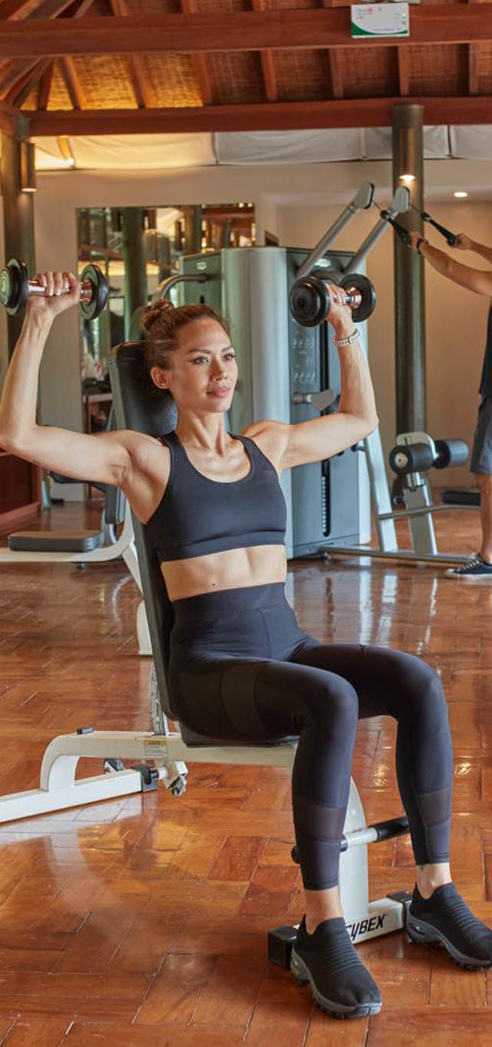Long-distance travel can be incredibly rewarding, but comes with health impacts from muscle stiffness to dehydration, germ exposure to jet-lag, and beyond. Therefore, staying fit and protecting your health requires a proactive approach.
First, some basics: always consult a healthcare professional before making the decision to travel. Whether you have an underlying health condition or simply need your vaccinations updated, this is a critical step to ensuring your journey goes smoothly health-wise.
Also, make sure to carry a face mask to protect yourself (and others) during time spent on the plane or in crowded places. It’s also a good idea to cover your face when air pollution levels are high or when there’s a spike in cases of COVID, flu, or other ailments. Bring along a pack of baby wipes to clean off unsanitary surfaces and don’t forget an emergency stash of toilet paper.
Finally, allow yourself plenty of time to navigate through airports. Plan your time wisely to avoid rushing, which can lead to accidents or injuries. Giving yourself some extra cushion in your schedule can help avoid unnecessary strains or twists.
Beyond these basics, you can drastically decrease possible negative health impacts of long-distance travel with just a few additional items in your wellbeing toolkit. Here are some easy-to-implement strategies tailored for pre-flight, in-flight, and post-flight fitness wellness.

Before You Go
Most people spend lots of time preparing for travel in terms of plans and packing, but the same should be true of your fitness regimen!
A modest amount of time engaging in longer walks or additional strength sessions before your departure can pay huge dividends in terms of enjoying an international trip.
Consider purchasing easy-to-carry equipment, like a jump rope or resistance bands, to aid in your preflight conditioning; when you arrive, you’ll already be used to incorporating these items into workouts, creating extra continuity between your pre-departure, in-location, and post-travel routines.
Here are a few practices to integrate before you leave to ensure you’re fit enough to enjoy your flight and make the most of your trip.
- Core Work: Strengthen your core muscles to protect your back. Exercises like planks, Russian twists, and bird dogs are some of your best bets here.
- Leg Strength: Build the muscles in your legs before departure to prepare for taking long walks and standing in long lines. Squats, lunges, and calf raises will build strength in these areas.
- Upper Body Conditioning: Get your upper body ready for lifting luggage and carrying bags by incorporating push-ups, shoulder presses, and dumbbell rows into your routine.
- General Mobility: Invest time in a stretching, yoga, or Qi Gong session before heading to the airport. Focusing on dynamic stretches can help prepare your muscles for a prolonged period of inactivity. Here is one of our favorite 10 minute Qi Gong routines.
- Cardio Exercise: Include some cardio workouts (such as a brisk walk, alternating intervals of walking and jogging, or an appropriately paced-run in the days leading up to your trip. This boosts your overall circulation and helps mitigate the risk of deep vein thrombosis (DVT) during your flight.
While In Flight
Many people see the time they spend on board the plane as a necessary price to pay for delivery to their desired destination, but with a bit of preparation, long-haul flights don’t have to be such a drag! Board with comfortable shoes and clothing – and perhaps a pair of compression socks – and try out the following to stay nourished and comfortable while you’re in the air:
Fitness at 30,000 Feet
- Stretch In Place: Utilize the space at the back of the plane to perform stretches such as forward bends, calf raises, hip flexor extensions and arm lifts. Even from the comfort of your seat, you can do light stretching with ankle circles, knee lifts, shoulder rolls, and upper body twists. Try maintaining each posture for 30 seconds, or 30 seconds per side.
- Get In Some Steps: Every couple of hours, take a moment to stretch your legs and walk around the cabin. Walk in place for five to 10 minutes or take three five-minute walks up and down the aisle.
- Mindful Breathing: Practice deep breathing exercises or meditation to reduce stress and improve oxygenation to your muscles.
- Sleep Management: On longer flights, try to align your sleep with the destination’s time zone to adjust your body clock in advance. Use eye masks and earplugs to help facilitate sleep.


Flight-Friendly Food for Fuel
Airport food can be hit or miss in terms of nutritional value. Packing your own healthy snacks ensures you have access to nutritious options that will keep your energy levels stable. Keep your foods low in sugar so you do not get fidgety and hyper on the flight. Think nuts, whole fruits, or whole-grain mini muffins. Finally, eat light – rather than one or two heavier meals, break up your flight with more frequent, smaller meals to aid digestion and avoid constipation.
Also, start hydrating well before your flight. The dry air in aircraft cabins is notorious for causing dehydration, which can exacerbate feelings of jet lag and fatigue. Avoid caffeine and alcohol, and instead drink plenty of water.
Hydration tablets and powders are an efficient means of re-hydration; plus, if you like their flavoring, they can help encourage you to drink more water. Here are some of our favorites:
- Nuun Tablets: These come in a variety of formulations and are designed to enhance your hydration by providing a blend of electrolytes, vitamins, and minerals in a convenient, portable form.
- Gnarly Nutrition Hydration Drink Mix: This powder offers balanced electrolytes (including a moderate amount of sodium), is NSF content certified, and comes in three flavors.
- Key Nutrients Electrolyte Recovery Plus: This formula is sweetened with stevia and offers all major electrolytes, providing a cost-effective, zero-calorie option available in various flavors.
- DripDrop Dehydration Relief Fast: Developed by doctors for mild to moderate dehydration, DripDrop is NSF certified for sport and free from stevia (but does contain sugar and fructose).
After You’ve Arrived
Once you’ve arrived, make time to engage in light exercise such as walking or stretching. It can be tempting to hit the ground running with an early morning on day one, but if you’re feeling fatigued, prioritize some rest to help your muscles relax, your immune system recover, and your internal clock reset to a new time zone.
In the days after arrival, utilize your hotel’s or resort’s fitness amenities (e.g., gym and spa), and take advantage of any group classes on-site or nearby. You’ll be doing your body a favor, plus you’ll have a chance to try something new or meet other wellness-minded people in the area.
In addition, consider checking out the numerous apps and gadgets now available to help travelers stay on top of their fitness and health goals while on the road. From hydration reminder apps to portable fitness devices that allow for in-room workouts, technology can be a valuable ally in combating the downsides of long-haul travel.
International travel is incredibly rewarding and life-enriching, and with a few simple measures you can make sure it doesn’t take a heavy toll on your body. Like this content? Subscribe to receive blog updates here.



In addition, consider checking out the numerous apps and gadgets now available to help travelers stay on top of their fitness and health goals while on the road. From hydration reminder apps to portable fitness devices that allow for in-room workouts, technology can be a valuable ally in combating the downsides of long-haul travel.
International travel is incredibly rewarding and life-enriching, and with a few simple measures you can make sure it doesn’t take a heavy toll on your body. Like this content? Subscribe to receive blog updates here.

